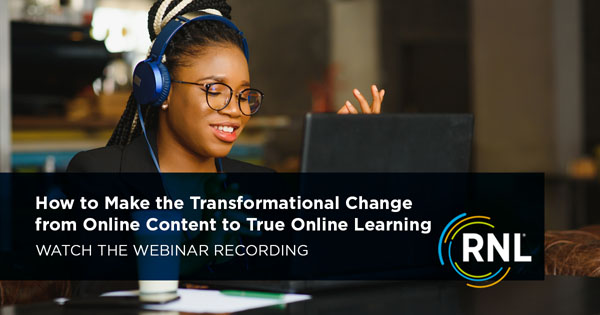enrollment
Managing the Transformation to Online Learning
Over the past year, remote learning was often times (due to necessity) not much more than transferring course content into your LMS. Faculty got really proficient, really fast, at uploading documents, uploading PowerPoint slides, holding Zoom meetings…and that’s what became known as “remote learning.”
But true online learning is more than just putting content into the LMS. It’s about creating interactive content with tech tools and videos and multimedia. It is also transforming learning—not just transferring content—and making sure that all content is accessible by students with varying needs and learning styles.
How do you know you are headed in the right direction?
Faculty perspective
There is a huge opportunity right now for schools to harness the learning that they’ve already engaged in with the faculty. Online learning is no longer a threat to anyone’s teaching style, and that is a change for the good. This past year has taught us that online learning can be transformational for students. COVID has pushed faculty and students into developing a comfort level with online learning—and it’s critical for institutions to take advantage of this incredible moment. The opportunity now is to connect all the knowledge that faculty have gained with what the future can look like.
We need to acknowledge and appreciate what faculty (to say nothing of students) have been though over the past year, while also appreciating the knowledge and expertise they have gained in this space. Then we need to transform that new knowledge and expertise—hastily learned and applied—into the highest quality instruction. How? By offering training that will teach them:
- How to load videos;
- How to use tech tools and multimedia options that are available within the LMS; and
- How to use accessibility tools that help to ensure universal learner access to content.
All of this is part of taking online learning to another level.
But that is likely not enough. It’s also vital for faculty to understand the relationship between the work that they do (developing world class academic content) and the work that should be led by professional instructional designers (translating that to the online universe). Many institutions need to overcome a perception among faculty that instructional designers are not necessary in online course design. Professional instructional designers can be seen as a threat to the subject matter expertise of the faculty and the teaching styles of each faculty member. In reality, however, collaboration between these two groups and understanding that they each serve an important role is what makes the magic happen in the online environment. When done right, instructional designers make the faculty look better and save them from having to learn some of the more arcane details of the LMS.

Content perspective
Let’s also acknowledge that incentivization is important. We all have seen this in action: faculty stipends for successfully creating an online course or program; a digital badge so they can promote themselves within the school, on LinkedIn, as an expert. All of these things make faculty feel rewarded and empowered for gaining those skills. This all helps advance the process and improve the content.
But that is not always enough. Faculty still often do not have the level of expertise needed to see how content that was designed for the classroom should be delivered to students who are not physically present. This is the “inflection point” at which instructional designers have spent their entire careers and where they dedicate their work days. In order to transform their content from remote learning to true online learning, schools either need to hire instructional designers or contract with an external partner with that expertise. From the first meeting with faculty, good instructional designers will present themselves as a partner to ensure that the expert course content developed by each faculty member is translated to maximize its success with online students. This means that the instructional designer is helping faculty do what they do best.
They can look at course content and leverage the sophisticated technology tools in the LMS to enhance the interactivity of the experience and figure out how to increase interpersonal exchange and community building on their platform—the core challenge of almost any online course. This is so much more than just pasting static content into the LMS.
One of the ways that instructional designers can assist faculty members who want a more hands-on role in the translation of their content is to design templates that include all the best practices, then have faculty plug in their material in the appropriate places. Once your templates are customized, the instructional designer can train faculty on how to use them and engender a continued sense of ownership.
Where do I start?
Some institutions focus their instructional designers on their most popular programs or courses so that they can impact the largest number of students, while others take a broader approach so they can attract more students through their breadth of available offerings—thereby impacting a more diverse group of students. Both are credible routs to enrollment growth, but each institution needs to think about the resources that will be needed for either approach. Here are a few other starting points I have seen at institution I have worked with recently:
- One institution decided to focus on the transformation of content in its Counseling Psychology master’s program. Why? Because this was a program that was about as far away from one that the institution saw as “online-friendly” as possible. The program had put together a remote option in order to get through the pandemic, but leaders thought that they may need to be prepared for the next thing to happen and therefore leveraged instructional design expertise to ensure that they types of interpersonal thing that such a program needs could be optimized online.
- Another institution decided to focus on its general education curriculum. Why? So that they could immerse new students in high quality online experiences from the very beginning and thereby reduce the types of dissatisfaction that rumbled through the traditional undergraduate community last fall after experiencing “remote learning.”
- Another institution decided to focus on ensuring that its online courses and programs in technology-related programs were the initial focus of its instructional design advancements. Why? Because these students are likely to be the most demanding in terms of the expectations of technology-driven learning.
Either way you decide to go, it is vital that part of your decision making “rubric” should be to think through who the audience is for each course or program. This varies widely by course and program and can lead to very different approaches. For example, if you’re considering data science courses or some other sort of technology-based courses, those are learners that are used to using higher tech. They have higher expectations in terms of what’s available in the LMS. An online psychology or business or education student are likely to have very different expectations.
How do we assess success?
The very first step of this is to look at risk. Start with risk and as well as accessibility and be diligent about making sure that the courses are compliant. A best practice that we see from a lot of schools is developing a peer-to-peer approach and train people to be quality checkers across the institution. I suggest having people who want to volunteer to participate in peer reviews and audit each other’s courses or programs.
There are also so many online learning communities that are available to help schools in this space. Whether through spaces such as LinkedIn, Google, or various online learning communities, I suggest that schools provide faculty the tools to look in there for different evaluative rubrics that are readily available for auditing courses in online environments.
And finally, RNL can help evaluate your current state and take your courses to the next level with our instructional design team. From workshops with faculty to wholesale programmatic develop, RNL is there to partner with you to develop true online learning.
How does this impact enrollment?
We know our student population is used to seeing shows in their queue selected just for them and their interests, or having Amazon recommend just the right thing at just the right time. Students have these same expectations when they interact with your institution. And it’s not just during the enrollment process where they expect that the schools use these high tech digitized kind of methods or digital methods. They expect that when they get into the classroom, they will receive that same consistency and that level of sophistication in their online coursework.
One of the goals through this process must be developing lifelong learners. They have a great recruitment experience, a great learning experience, and it makes them want to do it again, whether it be through a certificate, a badge, or another advance degree. The user experience needs to be aligned through all of their experiences with the school, from beginning to end. That is where the revenue can develop and be truly reoccurring—but you have to tie in best practices throughout the student experience.
Ready to transform your online learning experience? Here’s how we can help
Through our RNL Enable suite of online enrollment solutions, we provide a full-blown consulting program for a school focusing on their online learning experience. We can come alongside them for smaller pieces of online program development, and we have an amazing digital design team that has digital expertise in full program development and course development. We can also do faculty training and workshops, and we can also provide feedback and advice on putting multimedia content integrated into your LMS or integrated into your courses. Reach out and we’ll set up a time to talk.
Transform your approach to online learning
Watch our on-demand webinar to see how you can develop an online course development strategy that achieves learning objectives and satisfies students…even if the course is intended to be taught face to face.
You can also see how our teaching and learning solutions can elevate the online learning experience with expert instructional design—including the curriculum planning, course design, and training and support you need to provide a premiere online learning experience. Learn more.

